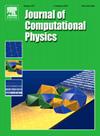Adaptive time-stepping Hermite spectral scheme for nonlinear Schrödinger equation with wave operator: Conservation of mass, energy, and momentum
IF 3.8
2区 物理与天体物理
Q2 COMPUTER SCIENCE, INTERDISCIPLINARY APPLICATIONS
引用次数: 0
Abstract
The aim of this paper is to establish an efficient numerical scheme for nonlinear Schrödinger equation with wave operator (NLSW) on unbounded domains to simultaneously conserve the first three kinds of invariants, namely the mass, the energy, and the momentum conservation laws. Regarding the mass and momentum conservation laws as the globally physical constraints, we elaborately combine the exponential scalar auxiliary variable (ESAV) method with Lagrange multiplier approach to build up the algorithm-friendly reformulation which links between the invariants and existing numerical methods. We employ the Crank-Nicolson and Hermite-Galerkin spectral methods for temporal discretization and spatial approximation, respectively. Additionally, we design a new adaptive time-stepping strategy based on the variation of the solution to improve the efficiency of our scheme. At each time level, we only need to solve a linear system plus a set of quadratic algebraic equations which can be efficiently solved by Newton's method. To enhance the applicability of the proposed scheme, we extend our methodology to N-coupled NLSW system where the mass, the energy, and the momentum are simultaneously conserved at the fully-discrete level. Numerical experiments are provided to show the convergence rates, the efficiency, and the conservation properties of the proposed scheme. In addition, the nonlinear dynamics of 2D/3D solitons are simulated to deepen the understanding of NLSW model.
求助全文
约1分钟内获得全文
求助全文
来源期刊

Journal of Computational Physics
物理-计算机:跨学科应用
CiteScore
7.60
自引率
14.60%
发文量
763
审稿时长
5.8 months
期刊介绍:
Journal of Computational Physics thoroughly treats the computational aspects of physical problems, presenting techniques for the numerical solution of mathematical equations arising in all areas of physics. The journal seeks to emphasize methods that cross disciplinary boundaries.
The Journal of Computational Physics also publishes short notes of 4 pages or less (including figures, tables, and references but excluding title pages). Letters to the Editor commenting on articles already published in this Journal will also be considered. Neither notes nor letters should have an abstract.
 求助内容:
求助内容: 应助结果提醒方式:
应助结果提醒方式:


